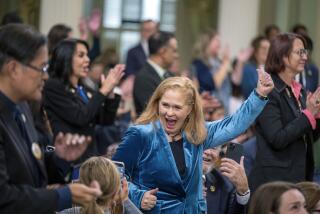State special elections are a waste
- Share via
California needs to change the way it fills state legislative vacancies. Current law requires a special election that often creates a chaotic, costly and time-consuming process of legislative musical chairs. The state soon will have had half a dozen legislative special elections this year, and easily could have at least another half-dozen to fill vacancies later this year.
Why so many legislative vacancies that trigger special elections? First, term limits. Termed-out legislators often leave old jobs early for new elected positions. Second, with more competitive congressional districts because of the independent reapportionment commission, there are more opportunities for state legislators to run for Congress. Finally, recent recurring state legislative salary freezes and reductions mean more state representatives are running for higher-paying local offices (this is especially true in Los Angeles County).
Special elections to fill vacant legislative seats present many problems. One is that waiting to schedule an election means a seat can stay vacant for months. During that time residents of the district have no vote in the Legislature — a classic case of taxation without representation.
Special elections are also a distraction. After general elections in the fall of even-numbered years, we want elected leaders to focus on governing. But special elections mean more fundraising, more partisanship, more politicking and less governing.
Special elections often aren’t representative because the turnout is notoriously poor. For example, in the recent special election in the 32nd Senate District (in Los Angeles and San Bernardino counties) less than 10% of registered voters cast ballots. And these voters tend to be more partisan and ideologically driven, and moderate voices are significantly diminished.
Special elections are a burden on taxpayers and county government, especially in less populated counties. And with voter turnout so low, many polling places have very few “customers.” In the 32nd Senate District election, for example, the costs are estimated to have exceeded $2 million, or close to $50 per vote cast — not a smart way to do business. In the last decade, Los Angeles County has had more than a dozen special elections costing more than a total of $12 million.
So, what can be done to fix this broken system? There are a couple of common-sense alternatives for which there is precedent in the state Constitution.
One solution is for the governor to fill all state legislative vacancies. Vacancies for U.S. Senate and county supervisor are already filled by gubernatorial appointment, and it has worked well. It is timely, costs taxpayers nothing and avoids the distraction of state legislators focusing on another election rather than governing.
Or the governor can fill legislative vacancies subject to confirmation by both houses of the Legislature. This procedure is now followed when there is a vacancy for constitutional offices such as state treasurer or state superintendent of public instruction. The advantage of this approach is that it does not give one person complete control over the appointment process. The disadvantage is that the confirmation process may result in legislative deadlock or take months to complete.
In these reform proposals, the appointment would be valid only until the next general election. Thus, the district’s voters would have an opportunity to make a change in a reasonable time period if they want someone else to represent them.
Eliminating special elections also could bring greater legislative diversity. A recent analysis by the Public Policy Institute of California found that more than 75% of newly elected legislators were former legislative aides or local elected officials. Under either reform proposal, the governor could appoint, for example, a candidate not affiliated with either major party, a blue-collar worker or a college student — all important constituencies with no direct voice in legislative deliberations.
Currently, 25 states have some form of appointment process for legislative vacancies. Legislative vacancy reform would require a change in the state Constitution subject to voter approval. But such common-sense reform deserves a place on the 2014 ballot. California elections need to be timely, not endless.
Gary K. Hart was a state legislator representing from Santa Barbara from 1974 to 1994.
More to Read
A cure for the common opinion
Get thought-provoking perspectives with our weekly newsletter.
You may occasionally receive promotional content from the Los Angeles Times.






